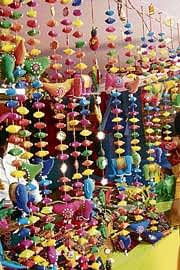Tradition comes calling

Traditional art forms are now more accessible than ever, and globalisation has increased awareness of the same, and has taken it beyond the level of a trend.
Ethnic arts maintain a history and quality that cannot be replicated through modern means of mass production.
“Today, culturally inspired home accents range from traditional ethnic arts to more contemporary designs. In addition to natural materials, ethnic home accents may also be made of reclaimed or recycled materials. Cultural arts often integrate reclaimed metal, reclaimed wood, or other recycled materials into innovative art forms. There are a number of traditional textile options from various states and countries. You will find handpainted and batik options in pillow cases, table cloths, table runners and place mats that are culturally rich and adorn a distinctive look. For an interesting way of displaying fabric art, one can use a story-depicting quilt as a wall hanging illustrating the life of a tribe,” according to Puja Pusalkar, Design Head, Portico NY, India.
A riot of colour
Whether it is Madhubani paintings, dhurries from Warangal or vibrant artifacts from Gujarat, the colours of India shine through. Nature, wild animals, colourful fabrics and woodcarvings inspire ethnic décor.
Often you will see vivid colours integrated with the neutral colour of the natural fibres, creating a wide variety of colourful designs and patterns for functional or decorative use. Colours can range from bright hues of orange, red, and turquoise to darker shades of burnt orange and burgundy. Most colours are natural and derived from vegetable resources.
Some of the traditional forms of art, which can be used in the décor of a house are Rajasthani Pichhvai, Patha Chitra from Orissa, matchstick drawings, Tanjore paintings, Maithili paintings etc.
“Traditional art pieces look elegant and rich as they depict our cultural heritage. Most of the paintings depict episodes from epics like Ramayana and Mahabharatha. For instance, there is a very colourful Patha Chitra made on pure silk which depicts Krishna and Balram leaving for Mathura from Brindavan that I have mounted in my daughter’s room.
Traditional art pieces like these are a pictorial way of educating our children about the glorious stories from our epics,” says Mythili G Nirvan, a professional working with a public relations firm. In fact several corporates are incorporating traditional artifacts as opposed to contemporary ones to give a rustic feel.
Says G B Prabhat, Founder & CEO, Anantara Solutions, “from paintings to decals to furniture to artifacts like pillars, traditional art can be used for making offices distinctive, warm and friendly. At Anantara, we have used Chettinad pillars, custom wall paintings of Chennai teashops, scenes of Chennai in decals and period furniture replicas to invoke a local feeling.”
Nature of use
The beauty of traditional art pieces is they can adorn not only a room with ethnic décor but can also enhance a room styled in contemporary furniture and furnishings. One of the ways of making a traditional art piece blend well with the ambience of a room would be to frame it appropriately.
“Baskets are characteristically lidded and vary in shape, including teardrop, oval and square designs, creating a wide variety of colourful designs and patterns for functional or decorative use. Besides having an aesthetic appeal, these serve as an alternative for storage for various household objects. “I have used a solid rose wood frame with intricate animal carvings to mount the Pichhvai in my ethnic guest room, which suits the ambience well,” explains Nirvan.
Lacquered and hand painted furniture as well as furniture made from coir, bamboo and other natural fibres create an eco chic atmosphere in the home. One could also use blinds or window coverings and lamp shades made from traditional Indian textiles with traditional blocks or bamboo. “Instead of using art as art form, it makes sense in using them as elements of architecture. Indian art form in a building could range from the reuse of ethnic doors, windows, columns, floor tiles, roof tiles and other elements of architecture. This not only adds to the traditional value, but proves more economical. The use of material can create art forms. The very form could justify use,” opines Prof Jaisim, Jaisim Fountainhead. In fact when you want to invest in art, buy original pieces especially since many art forms are dying. So by making simple choices that are not very heavy on the pocket and yet helping an artisan, you can do wonders in your home. Try it for yourself it will be a win-win situation.
Deccan Herald is on WhatsApp Channels| Join now for Breaking News & Editor's Picks